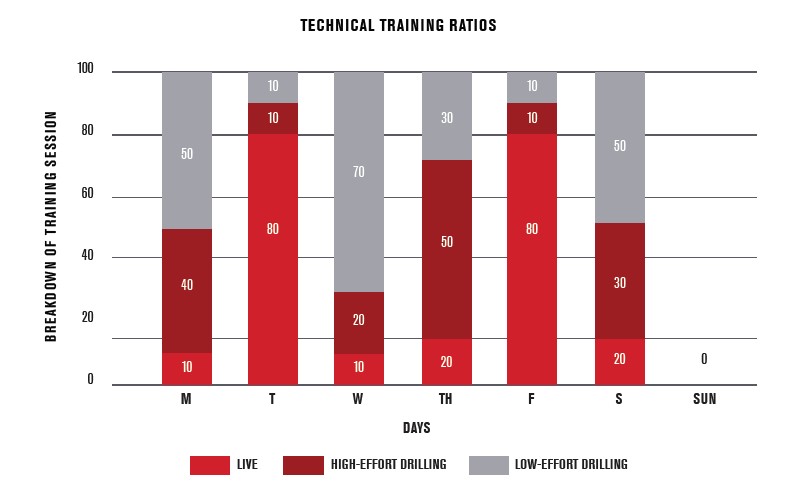So, you’ve landed your next fight! Whether it’s your first or your tenth, there is always room to make improvements to your fight preparation. Many make the mistake of training poorly year-round then starting a “fight camp” 8 weeks out where volume and intensity skyrocket as they try to get in shape.
Don't be like these fighters. Lay your foundation year-round and once you're ready to prepare for an upcoming fight, follow these six steps.
Step 1: Assess Your Opponent
This is your first step to giving you the best chance of winning your fight. Don’t take this lightly. You’ll hear of some fighters just “winging it” and focusing on their own game. Sure, focusing on your own game is vitally important.
But it’s just as important to know what is going to come at you in the ring, octagon, or on the mats. Are they a stand-up fighter? Do they love to wrestle? What do they do in these situations? Any “tells” that you can pick up that signal a specific offensive technique?
Thorough video analysis with your coach will give you all of these answers and more which will help shape your 8-week fight build-up.
Step 2: Alter Your Technical Sessions

Now that you have a good grasp on your opponents’ tendencies, now you can plan your technical training sessions to address these situations. For example, if your opponent loves trapping fighters against the cage for takedowns, you might spend a lot of time drilling takedown defense against the fence.
Another grappling example may be if an opponent is very good at various leg locks, you’d spend a lot of time in live leg lock defense scenarios also known as positional sparring.
If there are certain cues that the opponent shows before using a technique, you can have sparring partners use the same cues and techniques so you can recognize them during the fight and react accordingly.
One big change MMA fighters will make in their build-up is to blend their technical sessions instead of splitting them up into separate martial arts.
For example, instead of a BJJ session, it should be MMA grappling using different scenarios (fence, getting to feet, top position, etc).
Ideally, this is the time to double down on your strengths while preparing for what is coming from your opponent.
Step 3: Plan Your Sparring Sessions
As you can see from the technical planning, much of the change is presenting a lot of live situations. Also known as sparring. Sparring doesn’t have to mean full 3 x 5-minute MMA rounds or full 2–3-minute rounds for other striking arts. It means putting yourself in more live situations where you can drill specific scenarios.
For example, a boxer might notice performs a specific maneuver when backed into the corner of the ring. So, a live sparring session might be a live scenario where you need to cut your sparring partner off in the corner of the ring.
For an MMA fighter, it might be focusing on live fence defense. If planned correctly, you could have some form of live sparring in most training sessions to adequately prepare you for the fight.
The new UFC PI Handbook provides a great graphic into how this can look.

Courtesy of UFC PI
As you can see, two big sparring days would involve mainly live rounds with some positional sparring. Other days have 10-20% of live training which would be best suited for situations that I mentioned above.
Step 4: Periodize Your Strength And Conditioning
If you've done the grunt work before your camp, you are ready to transition your strength and conditioning training where you are putting the icing on the cake. You are now at the end of what I like to call, the Funnel System.

Your main conditioning focus should be alactic capacity (and power to some extent) and anaerobic lactic capacity (and power to some extent). What you will find however is that the overall intensity of your technical sessions has increased dramatically compared to before camp. Mainly due to the increase in live training.
This means now is NOT the time to also increase the volume of conditioning training. Regarding your strength training, two days per week is the sweet spot. Any more is just too much on top of your crazy fight training schedule.
There are two ways you can tackle this. You can either perform one upper and one lower strength/power day which keeps your upper or lower body fresh for the rest of the week. Or you can perform one strength-focused day and one power-focused day which are both full body.
The direction you take is going to be up to you. I’m fond of both training splits and I’ll give an example of both in the fight camp plan section.
During these strength training sessions, it’s not about volume. It is purely about intensity and speed. As you get closer to the fight, the loads will be lighter and it’s purely about maximizing power output.
Step 5: Nail Your Routine

Preparing for a fight is more than just the physical. You must prepare yourself mentally and emotionally. One way to do this is to dial in your routine. You should have a routine for everything you do. How you warm up for training should be a routine.
For example, you eat this specific meal exactly 1 hour before training because that is what makes you feel best. But you also need a competition routine. That starts with what you do when you get to the warm-up room. How you get your hands wrapped and how far before the fight. When you start moving and stretching.
This is just the beginning of your routine. You also need a routine for walking about the ring, mats, or cage. How fast do you walk? How do you get into the cage, ring, or on the mats? Do you always perform two jumps? Do you go through the second rope?
All of these things need to be practiced. Not just thought about. Practice your walk-in. Practice how you enter the fight arena. Then once you've nailed your routine, visualize it over and over again.
Mental skills coach Mona Pretorius de Lacey often talks about visualizing as not just seeing what you are going to do but using all of your senses.
How does it smell when you are walking to the arena? The taste of your mouth guard. The roaring of the crowd or your walkout song. The feel of your hands being wrapped and inside a snug glove. All of these things can be visualized so you know exactly what to expect on fight night.
Step 6: Start Your Weight Cut
The weight cut will make or break your fight performance. And it is a fine line between coming out as an energetic monster and being weak and fatigued. Dr. James Morehen has laid out a full-weight cutting guide that takes you through the exact plan he uses with professional boxer Rocky Fielding.
If you are dropping weight for your fight, you need to gradually reduce your body weight well before your last week. The safe range of cut weight the week of the fight is 5-8% of your body weight. So, if you are competing as a 185 lb fighter, then you should be anywhere from 194-200 lbs the week of the fight.
From there, it is only from 2 days out from the fight do you start to reduce your carbohydrate and 1 day out do you start to reduce your fluid intake. This is how you maximize your performance as you are not depleting yourself for a whole week or by dropping a lot of body weight quickly.
8-Week Fight Camp Plan
I don’t like the term “fight camp.” What is a fight camp anyway? Aren’t you already training year-round multiple times a week? Everything should a smooth transition from one phase to the next. If you are 8-weeks out and suddenly blast the training intensity and volume with brand new exercises and drills, you’re going to be in for a rough ride.
When you are 8-weeks out from a fight, your training will change slightly. But it should not be a huge overhaul. In this “fight camp” example, I’m going to keep terms very general so they can be applied to any combat sport.
When I mention technical drilling, this should consist of either doubling down on your strengths and/or drilling the solutions to what your opponent is presenting from your video analysis. Live sparring should involve some positional sparring and also full live sparring.
8 Weeks Out
Header | AM | PM |
|---|---|---|
Mon | Technical Drilling (Easy) 50% + Technical Drilling (Hard) 40% + Positional Sparring 10% 90 mins | Alactic Power 2x (5 x 9sec w/ 2 min light movement between reps) |
Tue | Technical Drilling (Moderate) (40%) + Live Sparring (60%) 90 mins | Full body strength OR Lower body strength & power + Lactic Power Intervals 2x (2 x 30sec/3min rest) w/ 5-8 min light movement between sets |
Wed | Technical Drilling (Easy) 70% + Technical Drilling (Moderate) 30% 70 mins | Cell |
Thu | Technical Drilling (Easy) 50% + Technical Drilling (Hard) 40% + Positional Sparring 10% 90 mins | Full body power OR Upper body strength & power |
Fri | Technical Drilling (Moderate) (40%) + Live Sparring (60%) 90 mins | Alactic Capacity 2x (12 x 12sec/60 sec rest) w/ 5-8 min light movement between sets |
Sat | Technical Drilling (Easy) 60% + Technical Drilling (Moderate-Hard) 40% 70 mins | Cell |
Total | 8h:20m | Cell |
7 Weeks Out
Header | AM | PM |
|---|---|---|
Mon | Technical Drilling (Easy) 40% + Technical Drilling (Hard) 50% + Positional Sparring 10% 100 mins | Alactic Power 2x (6 x 9sec w/ 2 min light movement between reps) |
Tue | Technical Drilling (Moderate) (30%) + Live Sparring (70%) 90 mins | Full body strength OR Lower body strength & power + Lactic Power Intervals 2x (3 x 30sec/3min rest) w/ 5-8 min light movement between sets |
Wed | Technical Drilling (Easy) 60% + Technical Drilling (Moderate) 40% 75 mins | Cell |
Thu | Technical Drilling (Easy) 40% + Technical Drilling (Hard) 50% + Positional Sparring 10% 100 mins | Full body power OR Upper body strength & power |
Fri | Technical Drilling (Moderate) (30%) + Live Sparring (70%) 90 mins | Alactic Capacity 2x (12 x 12sec/48 sec rest) w/ 5-8 min light movement between sets |
Sat | Technical Drilling (Easy) 50% + Technical Drilling (Moderate-Hard) 50% 75 mins | Cell |
Total | 8h:50m | Cell |
6 Weeks Out
Header | AM | PM |
|---|---|---|
Mon | Technical Drilling (Easy) 40% + Technical Drilling (Hard) 40% + Positional Sparring 20% 100 mins | Alactic Power 2x (5 x 8sec w/ 2 min light movement between reps) |
Tue | Technical Drilling (Moderate) (30%) + Live Sparring (70%) 100 mins | Full body strength OR Lower body strength & power + Lactic Capacity Intervals 2-3x (2 x 60sec/120sec rest) w/ 5-8 min light movement between sets |
Wed | Technical Drilling (Easy) 60% + Technical Drilling (Moderate) 40% 75 mins | Cell |
Thu | Technical Drilling (Easy) 40% + Technical Drilling (Hard) 40% + Positional Sparring 20% 100 mins | Full body power OR Upper body strength & power |
Fri | Technical Drilling (Moderate) (30%) + Live Sparring (70%) 100 mins | Alactic Capacity 3x (10 x 12sec/48 sec rest) w/ 5-8 min light movement between sets |
Sat | Technical Drilling (Easy) 50% + Technical Drilling (Moderate-Hard) 50% 75 mins | Cell |
Total | 9h:10m | Cell |
5 Weeks Out
Header | AM | PM |
|---|---|---|
Mon | Technical Drilling (Easy) 90% + Technical Drilling (Hard) 10% 60 mins | Alactic Power 2x (6 x 8sec w/ 2 min light movement between reps) + Technical Drilling (Hard) 80% + Positional Sparring 20% 60 mins (technical only) |
Tue | Technical Drilling (Moderate) (30%) + Live Sparring (70%) 100 mins | Full body strength OR Lower body strength & power + Lactic Capacity Intervals 2-3x (3 x 60sec/120sec rest) w/ 5-8 min light movement between sets |
Wed | Technical Drilling (Easy) 60% + Technical Drilling (Moderate) 40% 80 mins | Cell |
Thu | Technical Drilling (Easy) 40% + Technical Drilling (Hard) 40% + Positional Sparring 20% 110 mins | Full body power OR Upper body strength & power |
Fri | Technical Drilling (Moderate) (30%) + Live Sparring (70%) 100 mins | Alactic Capacity 3x (10 x 12sec/40 sec rest) w/ 5-8 min light movement between sets |
Sat | Technical Drilling (Easy) 50% + Technical Drilling (Moderate-Hard) 50% 80 mins | Cell |
Total | 9h:50m | Cell |
4 Weeks Out
Header | AM | PM |
|---|---|---|
Mon | Technical Drilling (Easy) 90% + Technical Drilling (Hard) 10% 50 mins | Alactic Power 2x (6 x 7sec w/ 2 min light movement between reps) + Technical Drilling (Hard) 40% + Positional Sparring 20% 70 mins (technical only) |
Tue | Technical Drilling (Moderate) (20%) + Live Sparring (80%) 110 mins | Full body strength OR Lower body strength & power + Lactic Capacity Intervals 2-3x (4 x 60sec/120sec rest) w/ 5-8 min light movement between sets |
Wed | Technical Drilling (Easy) 60% + Technical Drilling (Moderate) 40% 90 mins | Cell |
Thu | Technical Drilling (Easy) 40% + Technical Drilling (Hard) 40% + Positional Sparring 20% 120 mins | Full body power OR Upper body strength & power |
Fri | Technical Drilling (Moderate) (20%) + Live Sparring (80%) 90 mins | Alactic Capacity 3x (10 x 10sec/20 sec rest) w/ 5-8 min light movement between sets |
Sat | Technical Drilling (Easy) 50% + Technical Drilling (Moderate-Hard) 50% 90 mins | Cell |
Total | 10h:20m | Cell |
3 Weeks Out
Header | AM | PM |
|---|---|---|
Mon | Technical Drilling (Easy) 40% + Technical Drilling (Hard) 40% + Positional Sparring 20% 90 mins | Alactic Power 2x (5 x 7sec w/ 2 min light movement between reps) |
Tue | Technical Drilling (Moderate) (20%) + Live Sparring (80%) 90 mins | Full body strength OR Lower body strength & power + Full body strength OR Lower body strength & power + Lactic Capacity Intervals 1-2x (6 x 30sec/30sec rest) w/ 5-8 min light movement between sets |
Wed | Technical Drilling (Easy) 60% + Technical Drilling (Moderate) 40% 75 mins | Cell |
Thu | Technical Drilling (Easy) 40% + Technical Drilling (Hard) 40% + Positional Sparring 20% 90 mins | Full body power OR Upper body strength & power |
Fri | Technical Drilling (Moderate) (20%) + Live Sparring (80%) 90 mins | Alactic Capacity 3x (10 x 10sec/30 sec rest) w/ 5-8 min light movement between sets |
Sat | Technical Drilling (Easy) 60% + Technical Drilling (Moderate-Hard) 40% 75 mins | Cell |
Total | 8h:30m | Cell |
2 Weeks Out
Header | AM | PM |
|---|---|---|
Mon | Technical Drilling (Easy) 80% + Technical Drilling (Hard) 20% 60 mins | Alactic Capacity 2x (10 x 10sec/30 sec rest) w/ 5-8 min light movement between sets |
Tue | Technical Drilling (Easy) (20%) + Technical Drilling (Hard) 70% + Positional Sparring (Moderate) 10% 90 mins | Full body strength OR Lower body strength & power + Lactic Capacity Intervals 1-2x (6 x 20sec/30sec rest) w/ 5-8 min light movement between sets |
Wed | OFF | Cell |
Thu | Technical Drilling (Easy) 40% + Technical Drilling (Hard) 60% 60 mins | Full body power OR Upper body strength & power |
Fri | Technical Drilling (Easy) (20%) + Technical Drilling (Hard) 70% + Positional Sparring (Moderate) 10% 90 mins | Cell |
Sat | OFF or Light Aerobic Work (30 mins) | Cell |
Total | 5h:30m | Cell |
Fight Week
Header | AM | PM |
|---|---|---|
Mon | Technical Drilling (Easy) 80% + Technical Drilling (Hard) 20% 60 mins | Alactic Capacity 1x (10 x 10sec/40 sec rest) |
Tue | Full body speed and power | Cell |
Wed | OFF | Cell |
Thu | Technical Drilling (Easy) 90% + Technical Drilling (Moderate) 10% 60 mins | Cell |
Fri | Monitor Weight. Sweat If Needed | Weigh In. Refuel |
Sat | Relax OR 10-20 min Power Primer | Fight Night |
Total | 2h:00m | 00h:10m |
Please bear in mind this is a very, very general plan. It does not take into account when you can train, how much time you have to train, or anything about your strengths or weaknesses. Therefore, use this as a framework rather than an exact blueprint.
Most of these days are not split into double days for technical training. Some days can be split which I have provided an example for on Monday. However, the only reason you should split is for quality reasons. Secondly, some days don't suit split sessions as you don't want to perform fatiguing non-technical training in the morning when you have hard technical training in the afternoon.

